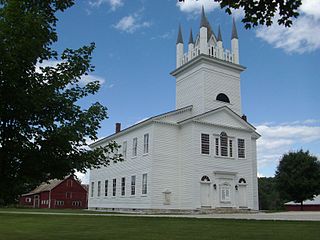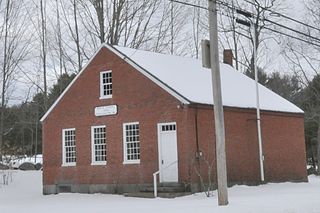
The Richmond Memorial Library is located on Ross Street in Batavia, New York, United States. It is an 1880s stone structure in the Richardsonian Romanesque style designed by Rochester architect James Goold Cutler.

The Leicester Meeting House is a historic church building at the junction of United States Route 7 and the Leicester-Whiting Road in the center of Leicester, Vermont. Built in 1829, it is a well-preserved example of vernacular Federal period church architecture executed in brick. It was listed on the National Register of Historic Places in 1988.

The South Tunbridge Methodist Episcopal Church is a historic church on Vermont Route 110, about one-third of a mile north of the Royalton town line in Tunbridge, Vermont. Built in 1833, it is one of the finest examples of late Federal period architecture in Orange County, and was a mainstay of social and civic life in southern Tunbridge for many years. It was listed on the National Register of Historic Places in 2001.

Sudbury Congregational Church, also known as the Sudbury Meetinghouse, is a historic church and town hall at 2702 Vermont Route 30 in Sudbury, Vermont. When it was built in 1807, it was a nearly exact replica of Plate 33 in Asher Benjamin's 1805 Country Builders Assistant. It was listed on the National Register of Historic Places in 1977.

The East Village Meetinghouse, also known as the Old Brick Church, is a historic church at 55 Vermont Route 14 in East Montpelier, Vermont. Built in 1833-34, it is a fine local example of Greek Revival architecture, and has been the focal point of the historic East Village for most of its history. It was listed on the National Register of Historic Places in 1980.

The former Young Men's Christian Association Building in Albany, New York, United States, is located on Pearl Street. It was built in the 1880s in the Romanesque Revival architectural style, with an existing neighboring structure annexed to it and a rear addition built in the 1920s. It was listed on the National Register of Historic Places in 1978. Two years later, when the Downtown Albany Historic District was designated and listed on the Register, YMCA building was further included as a contributing property.

The Acworth Silsby Library is the public library of Acworth, New Hampshire, located in the town center at 5 Lynn Hill Road. Built in 1891 and funded by Acworth native Ithiel Homer Silsby, the building is a distinctive local example of Romanesque architecture. The building was listed on the National Register of Historic Places in 1983.

The North School, also known locally as the Brick School, is a historic one-room schoolhouse at 63 Amesbury Street in Kensington, New Hampshire, United States. Built in 1842, it was the only brick schoolhouse built in the town, and is one of its four surviving 19th-century schools. Of those, it is the best-preserved, and is used as a local history museum. It served the town's educational purposes between 1842 and 1956, and is now a local history museum. The building was listed on the National Register of Historic Places in 2013.

The Brick School is a historic one-room schoolhouse on Cushman Road in Winslow, Maine. Built about 1810, it is one of the oldest surviving district schools in the state of Maine. It was listed on the National Register of Historic Places in 1977, and is now owned and maintained by the town's historic preservation committee

The Beaver Meadow School is a historic school building at 246 Chapel Hill Road in Norwich, Vermont. Built in 1922, it is a rare late example of a one-room schoolhouse, made further distinctive by the survival of its original schoolroom interior. The building was listed on the National Register of Historic Places in 2013.

Memorial Hall is a historic civic building at Church and West School Streets in Oakland, Maine. It was built in 1870 as a memorial to the community's American Civil War dead. It is a remarkably sophisticated example of Italian-Gothic architecture for a rural community, expensive to build, and was listed on the National Register of Historic Places in 1977.

The Twing Bucknam House is a historic house on United States Route 5 south of the main village of Windsor, Vermont. Built about 1840, it is a modest brick house with a combination of features that is unique to the state and the surrounding communities. It was listed on the National Register of Historic Places in 1996.

The Spencer Hollow School is a historic school building at 50 Spencer Hollow Road in Springfield, Vermont. Built about 1810, it is a fine local example of a district schoolhouse. It was used as a school until 1926, and as a clubhouse for a time thereafter. It was listed on the National Register of Historic Places in 2012.

The Old Stone Blacksmith Shop is a historic building on Vermont Route 30 in Cornwall, Vermont. Probably built in the late 18th century, it is a rare example in the state of a stone blacksmith shop, with a documented history of more than century's use for the purpose. It was listed on the National Register of Historic Places in 1975.

The District Six Schoolhouse is a historic school building on Elmendorf Road in Shoreham, Vermont. Built about 1833 and now converted into a residence, this modest stone structure is one of Vermont's oldest surviving district schoolhouses. It was listed on the National Register of Historic Places in 1977.

The Fairfield Street School is a historic school building at 78 Fairfield Street in the city of St. Albans, Vermont. Built in 1911, it served as a school until 1970, and is now converted into residential use. It is a prominent local example of Colonial Revival architecture, designed by Burlington architect Frank Lyman Austin. It was listed on the National Register of Historic Places in 1996.

The Kemp-Shepard House is a historic house on Highbridge Road in Georgia, Vermont. The main block of the brick house, built about 1830, is an important early work of a regional master builder, and it is attached to an older wood-frame ell. It was built on land that was among the first to be settled in the eastern part of the town. The house was listed on the National Register of Historic Places in 1997.

The South Hero Inn is a historic commercial building at 301 United States Route 2 in the center of South Hero, Vermont. Built in 1829, it is a prominent local example of a stone building with Federal and Greek Revival features, and served as a traveler accommodation until the early 1970s. It was listed on the National Register of Historic Places in 1975. It now houses a bank.

St. Albans Town Hall is the center of government of the town of St. Albans, Vermont. It is located at 579 Lake Road in the village of St. Albans Bay. It is a Richardsonian Romanesque building, constructed in 1898, two years after the city of St. Albans, the former town center, was politically separated. The building was listed on the National Register of Historic Places in 1996.

The William Hayden House is a historic house on Vermont Route 14 in southern Albany, Vermont. Built in 1854, it is a remarkably sophisticated example of Greek Revival architecture in brick for a small rural community. It was listed on the National Register of Historic Places in 1978.






















